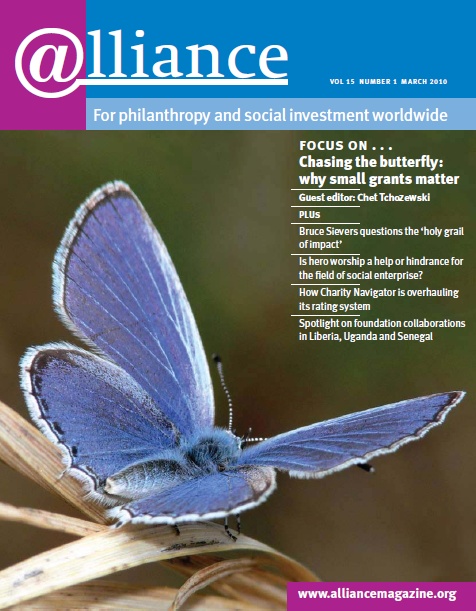The basis of this book raises a fascinating issue, perhaps best encapsulated by its subtitle – ‘where the soul meets a business plan’. As an individual, I reserve the right to respond emotionally when I encounter immediate need. As a grantmaker in an institutional context, I have the opportunity to sit down and think, to research and analyse alongside others, and then to take a decision that, though it may be rooted in an emotional commitment, is tempered by this more rational process. In short, and in this book’s terms – as an individual, it’s my soul that gives; as a philanthropoid, it’s a business plan. A book that seeks to synthesize the two is at least challenging.
A closely related issue has exercised the philosopher Peter Singer: in his recent book, The Life You Can Save, he seeks to understand why we fail to transfer our immediate compassion to the context of institutionalized giving. As he puts it, ‘If everyone who can afford to contribute to reducing extreme poverty were to give a modest proportion of their income to effective organizations fighting extreme poverty, the problem could be solved.’ But somewhere between the individual imperative to do good and the work at the frontline, there surely needs to be a trustworthy intermediary who takes the time to assess the quality and sustainability of the work – and that is a role for foundations. The challenge, which is what The Art of Giving is really and rightly about, is to do that job well while retaining the passion and concern that infused the original gift.
As Bronfman is a donor and Solomon is a philanthropy professional and expert, they are well placed to write about all of this. This very personal book is, in effect, the distillation of a 12-year partnership between them. Their aim, they say, is to ‘instruct donors, and would-be donors, on some of the truths of [our] trade, like the nature and definition of progress, the proper balance between ambition and resources, how to sort through the overwhelming number of opportunities, and such abstruse but essential matters as board governance and tax liabilities’. This is a big ask of a single 275-page volume, and some elements are necessarily superficial.
Perhaps the most interesting section is a detailed description of the process through which Jeffrey Solomon goes with new would-be donors in order to find out what really moves them, and therefore what should shape their philanthropy. In a process which he says is not therapy, but which surely comes close, Solomon (in the example recounted) reduces a reluctantly childless woman to tears as she responds to his probing, which leads to a focus in her philanthropy on the needs of children. There is something about this process that makes me uncomfortable – is that just because I’m a buttoned-up British middle-class male? Or is it because the idea of donor advisers turning into counsellors without the training that goes with it is at least questionable?
Solomon also uses a set of 25 motivational cards (see http://www.2164.net/store/tool/motivational-values-cards), asking potential donors to rank the values, which include things as diverse as Community, Equity, Power, Risk and Tradition. He points out that no one ever ranks ‘Power’ highly, but he hints that he takes that with the proverbial saline pinch. Another ‘trick’ involves asking donors which of nine choices of car they would like to be – the selection includes a Jeep, a pickup truck, a Mercedes and a tank.
This is a very American book. For example, in the section on non-profit board membership, the authors state uncritically that ‘Many boards expect financial contributions from their members, sometimes fairly steep ones, up to $10,000 and more’. In my experience, this is not the general expectation in the UK, and a good thing too, as board membership should surely not be limited to those with the deepest pockets. Alliance readers outside the USA will be too wise to assume that philanthropy emerging in the very specific cultural and social circumstances of that country is necessarily a guide to those of us living in countries which do not (yet) depend on private money to sustain the arts, higher education, healthcare, etc.
The book is thoughtful and well written, with the text helpfully broken up by interesting short case studies and cartoons. It ends with a substantial, and apparently comprehensive, guide to additional resources, including a reference to Alliance and the UK’s Trust and Foundation News. In the welter of books about aspects of philanthropy emerging from the US in recent years, this is one of the better efforts.
Steven Burkeman is an independent consultant, based in the UK, working mainly with foundations and human rights organizations. Email burkeman@gn.apc.org
The Art of Giving: Where the soul meets a business plan
Charles Bronfman and Jeffrey Solomon Jossey Bass £19.99/$29.95
ISBN 9780470501467
To order
http://www.josseybass.com





Comments (0)